
2005
Ahya VN, Doyle AM, Mendez JD, Lipson DA, Christie JD, Blumberg EA, Pochettino A, Nelson L, Bloom RD, Kotloff RM. Renal and vestibular toxicity due to inhaled tobramycin in a lung transplant recipient. J Heart Lung Transplant 2005; 24:932-935. [PubMed]

Fig,1 Vivek N Ahya
The safety of inhaled tobramycin in transplant recipients has not been established. The authors describe the first report of a lung transplant recipient who developed renal failure and vestibular injury after receiving inhaled tobramycin. The authors review the literature regarding the safety of inhaled tobramycin and discuss potential mechanisms that may promote systemic toxicity in transplant recipients.
Dr Vivek N Ahya (Fig.1) is Chief Medical Officer of Ambulatory Care and Clinical Transformation for the Clinical Practices of the University of Pennsylvania and Associate Professor of Medicine at the Hospital of the University of Pennsylvania.
Al-Aloul M, Miller H, Stockton P, Ledson MJ. Walshaw MJ. Acute renal failure in CF patients chronically infected by the Liverpool epidemic Pseudomonas aeruginosa strain (LES). J Cyst Fibros 2005; 4:197-201. [PubMed]

Fig.1a Mohamed Al-Aloul
Eight episodes of acute renal failure in adult CF patients, all occurring during the use of intravenous aminoglycosides for the treatment of pulmonary exacerbations with an epidemic multi-resistant Pseudomonas aeruginosa strain. Potential contributory factors are discussed.
These cases demonstrate another complication of infection by epidemic Pseudomonas strains in CF, and confirm the need for effective segregation policies to prevent this.
Dr Mohamed Al-Aloul (fig 1a) is a consultant in Respiratory Medicine, Wythenshawe Hospital Manchester
Armstrong DS, Hook SM, Jamsen KM, Nixon GM, Carzino R, Carlin JB, Robertson CF, Grimwood K. Lower airway inflammation in infants with cystic fibrosis detected by newborn screening. Pediatr Pulmonol 2005; 40:500-510. [PubMed]
Controversy exists over whether the lower airway inflammation that characterizes cystic fibrosis (CF) is initiated primarily by the genetic defect. To determine if inflammation precedes infection, we examined bronchoalveolar lavage (BAL) fluid cytology, cytokines (interleukin (IL)-1beta, IL-4, IL-5, IL-6, IL-8, IL-10, and tumor necrosis factor-alpha), and free neutrophil elastase activity from 70 CF (aged 1.5-71 months) children detected by newborn screening and 19 (aged 2.0-48 months) controls with chronic stridor. CF subjects were selected and categorized as pristine (13 aged </= 6 months, lacking prior respiratory symptoms and exposure to antibiotics, and without respiratory pathogens on BAL), infected (42 with viruses or >/= 10(5) colony-forming units/ml of pathogenic bacteria in BAL), and uninfected (15 aged > 6 months, asymptomatic, not taking antibiotics at bronchoscopy, and free of pathogens in their BAL). To further resolve if inflammation develops without infection, inflammatory mediators in paired annual BAL samples from 38 CF subjects were measured, and results were grouped according to whether BAL showed persistence (n = 6), acquisition (n = 8), clearance (n = 13), or absence (n = 11) of infection.
While pristine, uninfected, and control subjects had similar BAL profiles, infected patients showed elevated inflammatory indices, including increased IL-10 (P < 0.001). Pristine subjects had the fewest signs of inflammation. Analysis of BAL pairs found differences between the four infection groups for changes in neutrophil percentages, IL-8 (P < 0.001), and free neutrophil elastase (P = 0.009). Infection was associated with elevated inflammatory mediators in BAL fluid. In contrast, minimal or reduced signs of inflammation accompanied absence of eradication of infection from BAL fluid. We conclude that in CF, infection initiates and sustains airway inflammation.
— This rather complex study provides further evidence that infection usually precedes inflammation in the CF airways – this does not necessarily exclude the probability that the degree and duration of inflammation, when it occurs, is excessive in CF.
David S Armstrong is at the Department of Paediatrics, Monash Medical Centre, Monash University, Clayton, Victoria, Australia.
Aurora P, Bush A, Gustafsson P, Oliver C, Wallis C, Price J, Stroobant J, Carr S, Stocks J. London Cystic Fibrosis Collaboration. Multiple-breath washout as a marker of lung disease in preschool children with cystic fibrosis. Am J Resp Crit Care 2005; 171:249-256.[PubMed]

Fig 2. Paul Aurora. Author’s photo
Sensitive measures of lung function applicable to young subjects are needed to detect early cystic fibrosis (CF) lung disease. Forty children with CF aged 2 to 5 years and 37 age-matched healthy control subjects performed multiple-breath inert gas washout, plethysmography, and spirometry. Thirty children in each group successfully completed all measures, with success on first visit being between 68 and 86% for all three measures.
Children with CF had significantly higher lung clearance index (mean [95% CI] difference for CF control 2.7 [1.9, 3.6], p < 0.001) and specific airway resistance (1.65 z-scores [0.96, 2.33], p < 0.001), and significantly lower forced expired volume in 0.5 seconds (-0.49 z-scores [-0.95, -0.03], p < 0.05). Abnormal lung function results were identified in 22 (73%) of 30 children with CF by multiple-breath washout, compared with 14 (47%) of 30 by plethysmography, and 4 (13%) of 30 by spirometry. Children with CF who were infected with Pseudomonas aeruginosa had significantly higher lung clearance index, but no significant difference in other lung function measures, when compared with non-infected children.
— Most preschool children can perform multiple-breath washout, plethysmography, and spirometry at first attempt. Multiple-breath washout detects abnormal lung function in children with CF more readily than plethysmography or spirometry
Dr Paul Aurora (fig.2) is Consultant in Paediatric Respiratory Medicine and Lung Transplantation at Great Ormond Street Hospital for Children, London. He subsequently further developed this test for use in children with early lung disease (Aurora P. Thorax 2010; 65:373-374. [PubMed]). Predictably the test came into widespread use particularly for young patients. Paul Aurora has a major involvement in the paediatric transplantation programme at Great Ormond Street Hospital, London.
Barak A, Wexler ID, Efrati O, Bentur L, Augarten A, Mussaffi H, Avital A, Rivlin J, Aviram M, Yahav Y, Kerem E. Trampoline use as physiotherapy for cystic fibrosis patients. Pediatr Pulmonol 2005; 39:70-73.[PubMed]

Fig.3 Asher Barak ResearchGate
Physicians and physiotherapists who care for CF patients have recommended the use of trampolines as a methods of improving cardiopulmonary performance, encouraging sputum production, and improving general well-being. Despite some therapeutic and recreational benefits associated with trampoline use, papers in the paediatric literature mostly document an increased incidence of injuries, ranging from minor trauma to spinal cord injuries and even death!
This present review examined the accumulated published data regarding the use of trampolines, to assess their potential contributions and disadvantages for CF patients, and to define whether trampoline use should be recommended. There were approximately 60 articles that primarily dealt with trampolines, out of which only two dealt with CF. Unfortunately, most of these articles are reports pertaining to injuries related to the use of trampolines, with only a few describing the medical, physiologic, and/or psychological benefits of trampolines.
Based on the accumulated data, the presumed benefits of trampoline use for CF patients are not proven. Furthermore, the suggested benefits could be acquired using other types of exercise. Weighing the known definite risks of trampolines against the potential benefits that are not unique to this modality suggests that the use of trampolines for CF should not be recommended. In fact, the main outcome of trampoline use appeared to be injury!!
However, commenting on the Barak article Margareta Sahlberg and Birgitta Strandvik from Goteborg have seen no accidents in 5-6000 patient years using smaller trampolines of 150cms diameter (Pediatr Pulmonol 2005; 40:464.[PubMed]). No injuries have occurred with trampoline use at Box Hill Hospital, Melbourne (Currant J, Mahony M. Ir Med J 2008Jun:101(6):188. pubmed.ncbi.nlm.nih.gov/18700516/
Dr Asher Barak (fig.3) is at the Sheba Medical Center, Isreal
Barben J, Hafen G, Schmid J. Swiss Paediatric Respiratory Research Group. Pseudomonas aeruginosa in public swimming pools and bathroom water of patients with cystic fibrosis. J Cyst Fibros 2005; 4:227-231. [PubMed]

Fig.4 Jurg Barben
This study aimed to identify the prevalence of Pseudomonas aeruginosa (PA) in public swimming pools and water taps. Water was collected from public indoor and outdoor pools in the area of St. Gallen, Switzerland. In addition, standing and running water was sampled from bathroom water taps of 50 patients with CF. Outdoor pools: In 2002, none of the 72 specimens from 28 pools revealed PA. In 2003, three specimens from 46 pools (7%) revealed PA, each were from a different paddling pool. Indoor pools: two of 128 specimens from 56 pools (4%) identified PA, both were from non-public hydrotherapy pools. Water taps: in winter, none of the 102 specimens was colonized with PA. In summer, only two out of 50 specimens of the standing water were positive for PA but none of the running water revealed PA.
So the prevalence of PA in public swimming pools and bathroom water taps in the eastern part of Switzerland is very low. On hot summer days, outdoor paddling pools and standing tap water can contain PA. This study does not support recommendations to avoid public swimming pools or running tap water if the water is maintained according to hygiene guidelines. However, although the swimming pools in Switzerland are essentially free of bacteria unfortunately this is not general European experience. For example, a report from Northern Ireland found public swimming pools were frequently infected with PA (Moore JE et al. Incidence of Pseudomonas aeruginosa in recreational and hydrotherapy pools. Commun Dis Pub Health 2002; 5:23-26.[PubMed]). Also the consumer magazine “Which” in 2002 reported 35 of 61 samples from UK pools and spas fell outside acceptable bacteriological standards.
Prof. Jurg Barben (Fig.4) is at the Children’s Hospital, St Gallen, Switzerland
Berger AL. Randak CO. Ostedgaard LS. Karp PH. Vermeer DW. Welsh MJ. Curcumin stimulates cystic fibrosis transmembrane conductance regulator Cl- channel activity. J Biol Chem 2005; 280:5221-6. [PubMed]
Compounds that enhance either the function or biosynthetic processing of the cystic fibrosis transmembrane conductance regulator (CFTR) Cl(-) channel may be of value in developing new treatments for cystic fibrosis. Previous studies suggested that the herbal extract curcumin might affect the processing of a common CF mutant, CFTR-DeltaF508. Here, the authors tested the hypothesis that curcumin influences channel function. Curcumin increased CFTR channel activity in excised, inside-out membrane patches by reducing channel closed time and prolonging the time channels remained open. Stimulation was dose-dependent, reversible, and greater than that observed with genistein, another compound that stimulates CFTR. Curcumin-dependent stimulation required phosphorylated channels and the presence of ATP. They found that curcumin increased the activity of both wild-type and DeltaF508 channels. Adding curcumin also increased Cl(-) transport in differentiated non-CF airway epithelia but not in CF epithelia. These results suggest that curcumin may directly stimulate CFTR Cl(-) channels.
There is continuing interest in the role of curcumin in the treatment of cystic fibrosis (Colas J et al. Disruption of cyto-keratin-8 interaction with F508-CFTR corrects its functional defect. Hum Mol Genet 2012; 21:623-634.[PubMed]).
Bishop MD, Freedman SD, Zielenski J, Ahmed N, Dupuis A, Martin S, Ellis L, Shea J, Hopper I, Corey M, Kortan P, Haber G, Ross C. Tzountzouris J, Steele L, Ray PN, Tsui LC, Durie PR. The cystic fibrosis transmembrane conductance regulator gene and ion channel function in patients with idiopathic pancreatitis. Hum Genet 2005; 118:372-381. [PubMed]
Twelve (21%) of 56 patients with pancreatitis fulfilled current clinical criteria for the diagnosis of CF, but CFTR genotyping alone confirmed the diagnosis in only two of these patients. The authors concluded that extensive genotyping and ion channel testing (sweat tests and nasal potential differences) are useful to confirm or exclude the diagnosis of CF in the majority of patients with idiopathic pancreatitis.
Obviously CF should be considered in all patients with pancreatitis as it should in all men with congenital absence of the vas deferens.
Bishop C, Hudson VM, Hilton SC, Wilde C. A pilot study of the effect of inhaled buffered reduced glutathione on the clinical status of patients with cystic fibrosis. Chest 2005; 127:308-317. [PubMed]

Fig. 5 Clark Bishop
To assess the impact of inhaled, buffered reduced glutathione (GSH) on clinical indicators of CF pathophysiology, a randomized, double-blind, placebo-controlled pilot study was conducted over an 8-week period with 19 subjects, age 6 to 19 years. The mean change for peak flow was – 6.5 L/min for the placebo group and +33.7 L/min for the GSH group (p = 0.04). The authors concluded that this pilot study indicates the promise of nebulized buffered GSH to ameliorate CF disease, and suggest that longer, larger, and improved studies of inhaled GSH are warranted.
Dr Clark Bishop (fig.5) is a Utah paediatrician who has studied nebulised glutathione. Its potential use as a treatment for CF is viewed with enthusiasm by some writers on the web. Certainly there seems to be increasing scientific backing for its use.
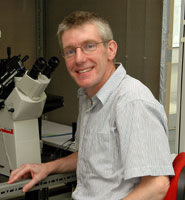
Fig.6 David Sheppard
In 2000, Dr David Sheppard (fig.6) of Bristol University summarised the situation in reply to a question put to the CF Trust; the main points of his reply were as follows – “In 1993 Dr Ron Crystal reported reduced levels of glutathione in the airway surface liquid of people with CF. In 1998 Drs Paul Linsell and John Hanrahan showed CFTR transports glutathione from inside to outside the cell but several less fold than chloride; Christine Bear suggests that CFTR may transport chloride and glutathione by different mechanisms. So glutathione transport is a normal function of CFTR suggesting that loss of CFTR contributes to the development and progression of CF. Dr Valerie Hudson of Brigham Young University has argued forcefully this point and in collaboration with Dr Clark Bishop has tested the effect on a small number of patients (this present trial)”.
There is a long article on Valerie Hudson (see 2004; a political science professor) and glutathione (www.womansday.com 3/4/03) describing how she convinced Clark Bishop of the potential value of glutathione to the extent that although he had some resistance from other researchers he raised $50K to fund the present trial.
Interest in glutathione has gradually increased and a more recent publication from the Bishop/Hudson collaboration was in 2008 (Visca A, Bishop CT, Hilton SC, Hudson VM. Improvement in clinical markers in CF patients using a reduced glutathione regimen: an uncontrolled, observational study. J Cyst Fibros 2008; 7:433-436. [PubMed]). In this study they followed 13 patients (age range 1-27 years) with cystic fibrosis who were using a regimen of reduced glutathione (GSH), including oral glutathione and inhaled buffered glutathione in an uncontrolled, observational study. Dosage ranged from 66-148 mg/kg/day in divided doses, and the term examined was the initial 5.5 months of GSH use (45 days of incrementally adjusted dose, plus 4 months of use at full dosage). Baseline and post-measurements of FEV1 percent predicted, BMI percentile, and weight percentile were noted, in addition to bacterial status and pulmonary exacerbations.
Significant improvement in the following clinical parameters was observed: average improvement in FEV1 percent predicted (N=10) was 5.8 percentage points (p<0.0001), average weight percentile (N=13) increased 8.6 points (p<0.001), BMI percentile (N=11) improved on average 1.22 points (p<0.001). All patients improved in FEV1 and BMI, if measured in their case; 12 of 13 patients improved in weight percentile. Positive sputum cultures of bacteria in 11 patients declined from 13 to 5 (p<0.03) with sputum cultures of Pseudomonas aeruginosa becoming negative in 4 of 5 patients previously culturing PA, including two of three patients chronically infected with PA as determined by antibody status.
The authors concluded the use of a daily GSH regimen appears to be associated in CF patients with significant improvement in lung function and weight, and a significant decline in bacteria cultured in this uncontrolled study. These findings bear further clinical investigation in larger, randomized, controlled studies.
A subsequent 12 weeks study from Germany of high dose n-acetylcysteine showed no effect on clinical parameters or inflammatory markers but it did increase the extracellular glutathione in the CF airways (Dauletbaev N et al. Eur J Med Res 2009; 14:352-358. [PubMed]). However, it looks as if there’s more to come on glutathione. Although none of the more recent publications show any significant benefit, there is a interesting report of three brothers who opted out of standard CF care for a regimen where oral supplements and nebulised glutathione were important components. (Clark T Bishop. Case report: Three adult brothers with cystic fibrosis (delF508-delF508) maintain unusually preserved clinical profile in the absence standard care. Respir Med Case Rep 2021;33:101413. www.ncbi.nlm.nih.gov/pmc/articles/PMC8348530/
Bolhuis PA, Page-Christiaens GC. The advisory report ‘Neonatal screening’ from the Health Council of The Netherlands]. [Dutch] Nederlands Tijdschrift voor Geneeskunde 2005; 149:2857-2860. [PubMed]
The Health Council of the Netherlands published an advisory report on neonatal screening in view of developments in diagnostics, therapy and the prevalence of neonatal diseases. Despite recommending neonatal screening for a vast number of rare metabolic disorders the council decided that a “better detection method for cystic fibrosis must be developed before it is included in screening to restrict the number of sweat-test referrals of unaffected newborns”.
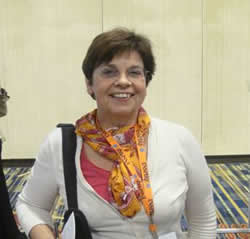
Fig. 7 Jeanette Dankert-Roelse Author’s photo
– This is really a rather surprising conclusion and quite out of keeping with both experience and the published evidence. The report must have been particularly frustrating for Dr Jeanette Dankert-Roelse (fig.7) of the Netherlands who has campaigned for CF screening for many years and first published on the subject back in 1983. [PubMed]. After further study to improve the test properties a four step protocol (IRT [immunoreactive trypsi], PAP [pancreatitis associated protein], screening for mutation panel and sequencing of the CFTR gene) was eventually introduced nationwide in the Netherlands but not until May 2010 (Cornel MC et al. J Inherit Metab Dis 2012; 35:635-640.[PubMed]). Quite astonishing state of affaires!
Bjarnsholt T, Jensen PØ, Rasmussen TB, Christophersen L, Calum H, Hentzer M, Hougen HP, Rygaard J, Moser C, Eberl L, Høiby N, Givskov M. Garlic blocks quorum sensing and promotes rapid clearing of pulmonary Pseudomonas aeruginosa infections. Microbiology 2005; 151(Pt 12):3873-3880. [PubMed]

Fig. 8 Thomas Bjarnsholt Copenhagen University Hospitals
Mice were treated with garlic extract or placebo for 7 days, with the initial 2 days being prophylactic before P. aeruginosa was instilled in the left lung of the mice. Bacteriology, mortality, histopathology and cytokine production were used as indicators. The garlic treatment initially provoked a higher degree of inflammation, and significantly improved clearing of the infecting bacteria. The results indicate that a QS-inhibitory extract of garlic renders P. aeruginosa sensitive to tobramycin, respiratory burst and phagocytosis by PMNs, as well as leading to an improved outcome of pulmonary infections.
– Subsequently a negative clinical trial of the use of garlic in CF was published in 2010 by Alan Smyth of Nottingham (Smyth AR et al. Pediatr Pulmonol 2010; 45:356-362.[PubMed]).The authors commented “Although there was no significant effect of garlic compared to placebo in this pilot study, there was a suggestion of improvement with garlic which should be investigated in a larger trial” Subsequently little has come of the use of garlic in CF treatment.
Thomas Bjarnsholt (Fig 8) is a professor in the Clinical Microbiology department of Rigshospitalet. Copenhagen.
Button BM, Roberts S, Kotsimbos TC, Levvey BJ, Willi of garlicams TJ, Bailey M, Snell GI, Wilson JW. Gastroesophageal reflux (symptomatic and silent): a potentially significant problem in patients with cystic fibrosis before and after lung transplantation. J Heart Lung Transpl 2005; 24:1522-9. [PubMed]
Gastroesophageal reflux (GER) may contribute to declining lung function before and after lung transplantation. Twenty-four patients were studied, GER, both symptomatic and silent, is a frequent and significant problem in people with CF after lung transplantation. The advice was that this condition should be aggressively treated and if necessary by surgery if the GER persists.
Conway SP, Wolfe SP, Brownlee KG, White H, Oldroyd B, Truscott JG, Harvey JM, Shearer MJ. Vitamin K status among children with cystic fibrosis and its relationship to bone mineral density and bone turnover. Pediatrics 2005; 115:1325-1331. [PubMed]

Fig 9. Steven Conway
The aim of this study was to assess vitamin K status in an unselected population of children with CF and to investigate any vitamin K effect on bone turnover and bone mineral status. One hundred and six children entered the study. Vitamin K1 deficiency was common (70%) and the authors suggested that routine supplements should be considered.
Through its role in the carboxylation of osteocalcin, vitamin K deficiency may be associated with an uncoupling of the balance between bone resorption and bone formation. However, a cause-effect relationship between vitamin K deficiency and low bone mass has not been proved.
Dr Steve Conway (Fig 9) is Director of the Leeds CF Service
Coraux C, Nawrocki-Raby B, Hinnrasky J, Kileztky C, Gaillard D, Dani C, Puchelle E. Embryonic stem cells generate airway epithelial tissue. Am J Resp Cell Mol Biol 2005; 32:87-92. pubmed.ncbi.nlm.nih.gov/15576671/
Embryonic stem (ES) cells are self-renewable and pluripotent cells derived from the inner cell mass of a blastocyst-stage embryo. ES cell pluripotency is being investigated increasingly to obtain specific cell lineages for therapeutic treatments and tissue engineering. Type II alveolar epithelial cells have been derived from murine ES cells, but the capacity of the latter to generate differentiated airway epithelial tissue has never been reported. Herein, we show by RT-PCR and immunocytochemistry that murine ES cells are able to differentiate into nonciliated secretory Clara cells, and that type I collagen induces this commitment. Moreover, when cultured at the air-liquid interface, ES cells give rise to a fully differentiated airway epithelium. By quantitative histologic examination, immunohistochemistry, and scanning electron microscopy, we show that the bioengineered epithelium is composed of basal, ciliated, intermediate, and Clara cells, similar to those of native tracheobronchial airway epithelium. Transmission electron microscopy and Western blotting reveal that the generated epithelium also exhibits the ultrastructural features and secretory functions characteristic of airway epithelial tissue.
The authors suggest these results open new perspectives for cell therapy of injured epithelium in airway diseases, such as bronchopulmonary dysplasia, cystic fibrosis, or bronchiolitis obliterans. Also pubmed.ncbi.nlm.nih.gov/16324647/
Davies JC, Davies M, McShane D, Smith S, Chadwick S, Jaffe A, Farley R, Collins L, Bush A, Scallon M, et al. Potential difference measurements in the lower airway of children with and without cystic fibrosis. Am J Respir Crit Care Med 2005; 171:1015-1019.[PubMed]

Fig. 10 Jane Davies Royal Brompton Hospital
The potential difference measurements were made via a bronchoscope from the lower respiratory tracts of children as young as 1 year. Tracheal baseline values were significantly higher in children with CF than those without, although this was not the case more distally. In airways between the third and seventh generation, perfusion with a zero chloride solution containing isoprenaline led to a significant change in potential difference in children without CF, whereas no change was seen in those with CF. This measure provided a reliable distinguishing test between the two disease groups This is the first report of this technique in children.
Dr Jane Davies (fig.10) is Professor and Hon. Consultant in Paediatric Respiratory Medicine and the senior paediatrician with the UK Gene Therapy Consortium at the Royal Brompton Hospital, London. Airway potential measurements are one of the end point measurements used by the Gene Therapy Consortium in their gene therapy trials which started in 2011. The trials involve patients down to the age of 12 years and the main multidose trial started in 2012. Eventually younger children will be involved in trials of either gene therapy or protein based therapies when these are shown to be safe and effective.
De Boeck K, Weren M, Proesmans M, Kerem E. Pancreatitis among patients with cystic fibrosis: correlation with pancreatic status and genotype. Pediatrics 2005; 115:e463-9. [PubMed]

Fig 11. Kris de Boeck
This multicentre study of 10071 patients with CF from 29 different countries revealed an estimated overall occurrence of pancreatitis among people with CF of 1.24% (10.3% in pancreatic sufficient and 0.5% in pancreatic insufficient patients).
Further confirmation that pancreatitis is a real risk for people with CF particularly if pancreatic sufficient. The overall incidence of pancreatitis reported by Jan Feigelson (2000 above) was 12.7%. Pancreatitis is identified by typical pain, evidence of inflammation on imaging and raised serum amylase or lipase.
Prof. Kris De Boeck (fig 11) is at the University Hospital, Leuven Belgium. She is one of Europe’s leading CF experts and received the ECFS Award in 2022.
Dodd ME, Prasad SA. Physiotherapy management of cystic fibrosis. Chron Respir Dis 2005; 2:139-149. [PubMed]

Fig 12. Mary Dodd

Fig.11a Armmani Prasad GOS website
This is a review by Mary Dodd and Armmani Prasad two of the recognised experts on the subject. They note that for many years physiotherapy for CF was synonymous with a daily routine of postural drainage and percussion. Improved longevity and a desire for independence, together with a clearer understanding of the pathophysiology of the disease, has led to the development of many airway clearance techniques. The contribution of ‘chest’ physiotherapy remained unchallenged until recent times when lack of robust evidence and the presentation of asymptomatic infants and adults led some physiotherapists to question this traditional approach. As survival increases into the fourth and fifth decade unique complications have evolved and physiotherapy management is challenged with non-respiratory aspects of treatment. This review considers the evidence for, and current practice of airway clearance, the value of exercise and the emerging problems of musculoskeletal complications and urinary incontinence.
Dr Mary Dodd (fig 12) now retired as consultant physiotherapist in the Manchester Adult CF centre. She was the co-founder, along with Prof. Kevin Webb, of the Bradbury Adult CF Centre in Manchester. Mary has been closely involved in CF clinical care and research for many years since starting working with CF with the late Dr Holzel in Manchester. She has published on most aspects of physiotherapy for people with CF and is a leading authority on the subject both in the UK and internationally
Ammani Prasad (Fig. 11a) is a physiotherapist who specialised in paediatric respiratory care, working extensively in the fields of paediatric intensive care and paediatric respiratory medicine, particularly cystic fibrosis for 25 years. More recently she has been involved in coordinating the work within the Cystic Fibrosis Unit at GOSH. She is extensively involved in joint work with the Cystic Fibrosis Trust and Department of Health regarding clinical pathways, commissioning of cystic fibrosis care and Peer Review. She now manages the Cystic Fibrosis Unit at GOSH.
Deterding R, Retsch-Bogart G, Milgram L, Gibson R, Daines C, Zeitlin PL, Milla C, Marshall B, Lavange L, Engels J, Mathews D, Gorden J, Schaberg A, Williams J, Ramsey B. Safety and tolerability of denufosol tetrasodium inhalation solution, a novel P2Y2 receptor agonist: results of a phase 1/phase 2 multicenter study in mild to moderate cystic fibrosis. Pediatr Pulmonol 2005; 39:339-348. [PubMed]

Fig 13. Robin Deterding
Denufosol tetrasodium is a selective P2Y2 agonist that stimulates ciliary beat frequency and Cl secretion in normal and CF airway epithelia enhanced by the effect of P2Y2 activation to also inhibit epithelial sodium transport.
Based on the results of this phase 1/phase 2 study, the Therapeutics Development Network (TDN) of the Cystic Fibrosis Foundation (CFF) and Inspire Pharmaceuticals, Inc., recently completed a multicenter, 28-day, phase 2 safety and efficacy clinical trial of denufosol inhalation solution in CF subjects with mild lung disease (Deterding RR et al. Am J Respir Crit Care Med 2007; 176:662-669 below; Kellerman D et al. Pulm Pharmacol Ther 2008; 21:600-607). [PubMed]
NB. There was a sad ending to the Denufosol story – following the report of a negative Phase III trial in 2010 further development of the drug for cystic fibrosis was discontinued.
Dr Robin Derterding (fig 13) is a paediatric pulmonologist and Professor of Pulmonary Medicine in the Department of Pediatrics at the University of Colorado School of Medicine and the Children’s Hospital where she is Director of the Pediatric Breathing Institute and of the Children’s Interstitial Lung Disease Research network. She is very active in research and clinical work.
Dupuis A, Hamilton D, Cole DE, Corey M. Cystic fibrosis birth rates in Canada: a decreasing trend since the onset of genetic testing. J Pediatr 2005; 147:312-315. [PubMed]

Fig 14. Mary Corey Author’s photo
The overall CF birth rate from 1971-1987 was 1 in 2714 with no increasing or decreasing trend. Beginning in 1988, 1 year before identification of the CF transmembrane conductance regulator gene, estimated CF birth rates followed a linear decline to an estimated rate of 1 in 3608 in 2000. CF birth rates may have stabilized in the last few years, but further decline may occur with implementation of carrier screening in the general population. These results demonstrate the temporal association of genetic testing and declining CF birth rates in Canada.
– Both neonatal screening in East Anglia (Green et al,1993 above) and antenatal screening in Edinburgh (Cunningham & Marshall, 1998 above) have been associated with a subsequent reduction in the incidence of CF in newborns in those areas – which perhaps is not surprising. We have also noted this in Leeds where neonatal screening has been routine in half the city since 1975 and citywide since 1995.
Dr Mary Corey (fig 14) has been a central member of the Toronto Sick Children’s CF unit since the Seventies and responsible for excellent long term patient data from that unit.
Dormer RL Harris CM, Clark Z, Pereira MM, Doull IJ, Norez C, Becq F, McPherson MA. Sildenafil (Viagra) corrects DeltaF508-CFTR location in nasal epithelial cells from patients with cystic fibrosis. Thorax 2005; 60:55-59. [PubMed]
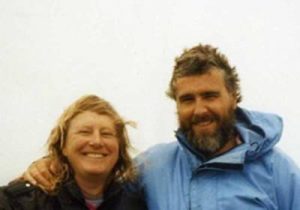
Fig 15. Richard Dormer with (wife and colleague) Maggie McPherson
Exposure of cells to sildenafil (2 hours at 37 degrees C) resulted in recruitment of DeltaF508-CFTR to the apical membrane and the appearance of chloride transport activity. Sildenafil also increased DeltaF508-CFTR trafficking in cells from individuals with CF with a single copy DeltaF508 (DeltaF508/4016ins) or with a newly described CF trafficking mutation (R1283M). The effects of sildenafil and vardenafil on CFTR trafficking were later confirmed using nasal potential differences in CF mice (Lubamba B et al, 2008). [PubMed]. Subsequent studies suggested that the high doses required to CFTR recovery might indicate that sildenafil may not be suitable as a therapeutic drug for CF lung disease (Leier G et al. Cell Physiol Biochem 2012; 29:775-790.[PubMed]).
– This was an early paper on sildenafil in CF and caused much interest. Subsequently there was a steady output of studies on various aspects of the drug in CF cells and patients, some related to improved exercise tolerance but the drug never became an important addition to treatment.
Drs Richard Dormer and Maggie McPherson (fig 15) were veteran CF researchers in the UK.
Doyen V, Fournier C, Bautin N, Cortet B, Flipo RM, Wallaert B. Rheumatoid arthritis and cystic fibrosis. [French] Rev Mal Respir 2005; 22:667-671. [PubMed]
Inflammatory arthropathies are rare complications of cystic fibrosis (CF). The authors describe three cases of rheumatoid arthritis (RA) occurring in patients with this disease. Among the 100 patients under the care of the adult CF centre in Lille 3 presented with RA. This developed at the ages of 17, 44 and 19 years with a FEV1 of 53%, 42% and 94% respectively. Rheumatoid factor and/or anti CCP antibodies were positive. The appearance and progression of RA were associated with exacerbations of bronchial infection and deterioration of respiratory function. In 2 patients the RA was continuously progressive despite intensive treatment involving high dose cortico-steroids, methotrexate (ineffective) followed by leflunomide (complicated by intractable respiratory infection). There is an increased incidence of RA in their patient population with CF. The evolution of the two diseases is related and seems to be dependent on the level of infection leading to therapeutic problems.
It is reasonable that the severity of arthritic complications whether definite RA or CF related arthritis are related to activity of the chest infection and thus the presence of inflammatory markers in the circulation. We reported this relationship in Leeds patients with CF related arthritis (Bowler IM & Littlewood JM, 1992. [PubMed]).
Drumm ML, Konstan MW, Schluchter MD, Handler A, Pace R, Zou F, Zariwala M, Fargo D, Xu A, Dunn JM, Darrah RJ, Dorfman R, Sandford AJ, Corey M, Zielenski J, Durie P, Goddard K, Yankaskas JR, Wright FA, Knowles MR. Gene Modifier Study Group. Genetic modifiers of lung disease in cystic fibrosis. N Eng J Med 2005; 353:1443-1453. [PubMed]

Fig 16. Mitchell Drumm CaseWestern website
Polymorphisms in genes other than the CFTR gene may modify the severity of pulmonary disease in patients with cystic fibrosis. 808 patients who were homozygous for the DeltaF508 mutation had either severe or mild lung disease (i.e. they were in the lowest or highest quartiles for FEV1). The authors genotyped 16 polymorphisms in 10 genes that had been reported by others as modifiers of disease severity in CF and tested for an association in the patients with severe disease (263 patients) or mild disease (545). In a second study, of 498 patients, with various CFTR genotypes and a range of FEV1 values, they tested for an association of the TGFbeta1 codon 10 CC genotype with low FEV1.
In the first study, significant allelic and genotypic associations with phenotype were seen only for TGFbeta1 (the gene encoding transforming growth factor beta1). The second study confirmed the association of the TGFbeta1 codon 10 CC genotype with more severe lung disease.
So genetic variation in the 5′ end of TGFbeta1 or nearby appears to modify disease severity in cystic fibrosis. Although these findings are academically interesting, and undoubtedly the way things will go in the future, it is likely that by far the most important determinant of survival remains the effectiveness of the medical care the patient receives.
Also European twin studies had suggested a genetic factor as the severity of the clinical expression was greater in monozygotic than in dizygotic twins (Mekus et al, 2000 above).
Prof. Mitchell Drumm (fig 16) is Connie and Jim Brown Professor in Cystic Fibrosis Research, Professor, Department of Genetics and Genome Sciences, School of Medicine, Professor, Department of Pediatrics Case Western Reserve University. Mitchell Drumm previously worked in the laboratory of Francis Collins with whom he was co-discoverer of the CF gene. He joined the faculty to Case Western Reserve University in 1992.
Endo R, Ishiguro N, Kikuta H. Usefulness of parenteral colistin in treating of lower respiratory infection due to multidrug-resistant Pseudomonas aeruginosa. [Japanese] Kansenshogaku Zasshi – Journal of the Japanese Association for Infectious Diseases 2005; 79:945-950.[PubMed]
A 19-year-old woman with CF suffered from frequent exacerbations of lower respiratory infection due to multidrug-resistant P. aeruginosa and was successfully treated with parenteral colistin. Multidrug-resistant Pseudomonas aeruginosa isolated from sputum had become resistant to all parenteral antibiotics commercially available in Japan. She did not show clinical improvement despite treatment with several different combinations of available antibiotics. She responded well to parenteral colistin without apparent side effects such as serious nephrotoxicity or neurotoxicity obtained from a pharmacy outside Japan. The authors conclude that colistin is therefore an important alternative antibiotic for treating multidrug-resistant Pseudomonas aeruginosa and its use should be considered in severe infection. They hope that parenteral colistin will become available in Japan in the near future.
– It is somewhat ironic that colistin had to be obtained from outside Japan as the antibiotic was discovered by Koyama et al in 1949, as a fermentation product of the bacteria Bacillus colistinus and the discovery had a direct bearing on the treatment of CF (see 1950 Koyama Y et al. A new antibiotic, colistin, produced by spore-forming soil bacteria. J Antibiot Tokyo. 1950; 3:457).
At first the drug was given intramuscularly (and apparently it was very painful) and in 1959 an intravenous formulation (colistimethate sodium) was released commercially; but this was temporarily abandoned in the Seventies due to reports of a high incidence of nephrotoxicity (Price et al, 1970; Koch-Weser et al, 1970) and also there was increasing use of intravenous gentamicin from 1968. More recently both nebulised and intravenous colomycin have been widely used outside Japan.
From the Department of Paediatrics Hokkaido University Hospital, Japan
Flume PA, Yankaskas JR, Ebeling M, Hulsey T, Clark LL. Massive hemoptysis in cystic fibrosis. Chest 2005; 128:729-738. [PubMed]

Fig 17. Patrick Flume cystic fibrosis foundation
Massive hemoptysis is a serious complication in CF patients, occurring more commonly in older patients with more advanced lung disease. Nearly 1 in 100 patients will have this complication each year. There is an attributable mortality to the complication and considerable morbidity, resulting in increased health-care utilization and a measurable decline in lung function.
Flume PA, Strange C, Ye X, Ebeling M, Hulsey T, Clark LL. Pneumothorax in cystic fibrosis. Chest 2005; 128:720-728. [PubMed]
Pneumothorax is a serious complication in CF patients, occurring more commonly in older patients with more advanced lung disease. Nearly 1 in 167 patients will experience this complication each year. There is an attributable mortality to the complication and considerable morbidity, resulting in increased health-care utilization and a measurable decline in lung function.
Dr Patrick Flume (Fig. 17) is in the faculty of the Pulmonary and Critical Care Division at the Medical University of South Carolina in 1993. He is now a professor of medicine and pediatrics and CF Center Director.
Frederiksen B, Pressler T, Hansen A, Koch C, Hoiby N. Effect of aerosolized rhDNase (Pulmozyme) on pulmonary colonisation in patients with cystic fibrosis. Acta Paediatr 2006; 95:1070-1074. pubmed.ncbi.nlm.nih.gov/16938752/

Fig 18. Birgitte Frederiksen & Niels Hoiby. author’s photo
Patients received either daily Pulmozyme or no Pulmozyme for 1 year. Positive cultures were obtained in 72% of treated and 82% of untreated patients. S. aureus was presented in 16% treated and in 30% of untreated. FEV1 increased by 7.3% in treated compared to only 0.9% of untreated group.
This was an observational study which, although the results were modest, provided practical valuable information that long term Pulmozyme appeared to reduce the need for antibiotics to eradicate new infections and also improved the lung function of patients who were not chronically infected.
Birgitte Frederiksen (fig 18) is a paediatrician at the Copenhagen CF Centre and involved in many of the research studies there particularly concerning treatment of the respiratory infection.
Fischer R, Lang SM, Brückner K, Hoyer HX, Meyer S, Griese M, Huber RM. Lung function in adults with cystic fibrosis at altitude: impact on air travel. Eur Respir J 2005; 25:718-724. pubmed.ncbi.nlm.nih.gov/15802349/

Fig. 18a Rainald Fischer BetterDoc
Current guidelines for air travel state that patients with chronic respiratory diseases are required to use oxygen if their in-flight arterial oxygen tensions (Pa,O2) drop below 6.6 kPa. This recommendation may not be strictly applicable to cystic fibrosis patients, who may tolerate lower Pa,O2 for several hours without clinical symptoms. Lung function, symptoms, blood gas levels and signs of pulmonary hypertension were studied in 36 cystic fibrosis patients at altitudes of 530 m and, after 7 h, 2,650 m. A hypoxia inhalation test (inspiratory oxygen fraction 0.15) was performed at low altitude in order to predict high-altitude hypoxaemia. Median Pa,O2 dropped from 9.8 kPa at low altitude to 7.0 kPa at high altitude. Mild exercise at a workload of 30 W further decreased Pa,O2. Two-thirds of all patients exhibited Pa,O2 of <6.6 kPa during exercise and, except for one patient, were asymptomatic. Patients were significantly less obstructed at an altitude of 2,650 m. Low forced expiratory volume in one second at baseline was associated with a low Pa,O2 at altitude. The authors concluded that cystic fibrosis patients with baseline arterial oxygen tensions of >8.0 kPa safely tolerate an altitude of 2,650 m for several hours under resting conditions. The risk assessment of low in-flight oxygenation should encompass the whole clinical situation of cystic fibrosis patients, with special attention being paid to the presence of severe airway obstruction.
Prof. Rainald Fischer (Fig 18a) is in the Dept. of Medicine, University of Munich
Fitzgerald DA, Hilton J, Jepson B, Smith L. A crossover, randomized, controlled trial of dornase alfa before versus after physiotherapy in cystic fibrosis. Pediatrics 2005; 116:e549-554. [PubMed]
This study shows that Dornase alfa is equally efficacious when delivered before or after physiotherapy/PEP in patients with CF. Patients who are infected persistently with P. aeruginosa may derive more improvement in FEV1 when dornase alfa is delivered after physiotherapy/PEP.
This is interesting and rather surprising.
Fridell JA, Vianna R, Kwo PY, Howenstine M, Sannuti A, Molleston JP, Pescovitz MD, Tector AJ. Simultaneous liver and pancreas transplantation in patients with cystic fibrosis. Transplantation Proceedings 2005; 37:3567-9. [PubMed]
Liver transplantation is the treatment of choice for end stage cirrhosis in this setting, but the addition of an isolated simultaneous pancreas transplant in patients with CF related diabetes had not been reported. Two female patients with CF underwent simultaneous pancreas and liver transplantation. Both patients recovered well with normal liver function, resolution of portal hypertension, and normal blood glucoses independent of insulin. As a result of the enteric exocrine drainage of the pancreas, the patients now also independent of supplemental pancreatic enzymes.
Simultaneous liver and pancreas transplantation in CF patients provides the advantages of normalization of glucose and improved nutrition for patients requiring liver transplantation and should be considered in CF patients with CF related diabetes who require liver transplants. This is one way to deal with both liver failure and CF related diabetes which is such a major additional problem for adults with CF.
Garside JP, Kerrin DP, Brownlee KG, Gooi HC, Taylor JM, Conway SP. Immunoglobulin and IgG subclass levels in a regional pediatric cystic fibrosis clinic. Pediatr Pulmonol 2005; 39:135-40. [PubMed]
Total immunoglobulin levels were measured in 154 patients and IgG subclass levels were measured in 136 patients and compared to age-related normal population data and to levels reported in previously published studies of children with cystic fibrosis. Eleven CF patients had hypergammaglobulinemia (7.8% compared with 0-69% in the published literature). Patients with hypergammaglobulinemia had lower FEV1 percent-predicted values, and worse clinical and x-ray scores than controls. Three patients had hypogammaglobulinemia (1.9% compared with 0-10.8% in the published literature). There was no difference in any clinical parameter between controls and those with hypogammaglobulinemia. Nineteen patients (14%) had low levels of IgG1, and 40 patients (29%) had low levels of IgG2.
The low percentage of patients with abnormally high immunoglobulin levels compared with previous studies probably reflects the improved respiratory status of today’s children with CF. The low percentage of those with low IgG probably reflects better nutritional status. The finding of worse lung function and clinical scores in patients with hypergammaglobulinemia agrees with the published literature and one’s clinical impressions. The high percentage of patients with low IgG2 was unexpected and had not been previously reported. The clinical significance of this in patients with CF is unknown. Also later follow-up of those with low subclass 2 levels showed no decline in clinical well-being and better condition compared with those with high levels of IgG2 (Garside JP et al. Pediatr Pulmonol 2007; 42:125-130.[PubMed])
Gooding I, Dondos V, Gyi KM, Hodson M, Westaby D. Variceal hemorrhage and cystic fibrosis: outcomes and implications for liver transplantation. Liver Transplantation 2005; 11:1522-6. [PubMed]
A case series of 18 patients is described and their survival compaerd with a control group of cystic fibrosis patients without liver disease. The median age at first bleed was 20.0 years (range 9.7-30.9). The median survival after first bleed was 8.4 years, compared to 13.0 years in the control group (P = 0.15). A total of 14 patients have died, 9 from respiratory disease with no discernable contribution from their liver disease. Liver disease contributed to 4 deaths. Only 1 patient suffered a fatal hemorrhage, which may have been either variceal or bronchial in origin.
Long-term survival is a frequent occurrence in patients with cystic fibrosis who suffer variceal hemorrhage, and age at death is comparable to the general cystic fibrosis population. In conclusion, this suggests that liver transplantation is not indicated in these patients without additional features of liver decompensation.
Here is extensive experience from the Brompton Hospital in London on the longterm outlook for patients who have variceal bleeds.
Hilliard T, Edwards S, Buchdahl R, Francis J, Rosenthal M, Balfour-Lynn I, Bush A, Davies J. Voriconazole therapy in children with cystic fibrosis. J Cyst Fibros 2005; 4:215-220.[PubMed]
A retrospective case note review of children with CF treated with voriconazole in a single centre over an 18 month period. A total of 21 children aged 5 to 16 years (median 11.3) received voriconazole for between 1 and 50 (22) weeks. Voriconazole was used as monotherapy in 2 children with recurrent allergic bronchopulmonary aspergillosis (ABPA); significant and sustained improvements in clinical and serological parameters for up to 13 months were observed, without recourse to oral steroids. Voriconazole was used in combination with an immunomodulatory agent in a further 11 children with ABPA, with significant improvement in pulmonary function and serology. 8 children without ABPA but who had recurrent Aspergillus fumigatus isolates and increased symptoms also received voriconazole; this group did not improve with treatment. Adverse effects occurred in 7 children (33%: photosensitivity reaction 3, nausea 2, rise in hepatic enzymes 1, hair loss 1). The authors concluded that voriconazole may be a useful adjunctive therapy for ABPA in CF. Voriconazole monotherapy appears to be an alternative treatment strategy when oral corticosteroids may not be suitable.
ABPA and even Aspergillus bronchitis were definitely more common and this is valuable experience in the use of an effective antifungal agent.
Hansen CR, Pressler T, Koch C, Hoiby N. Long-term azithromycin treatment of cystic fibrosis patients with chronic Pseudomonas aeruginosa infection; an observational cohort study. J Cyst Fibros 2005; 4:35-40. [PubMed]

Fig 18b. Christine Hansen
In 2001 long-term, low-dose azithromycin (AZ) treatment was introduced as an integral part of the routine treatment at the
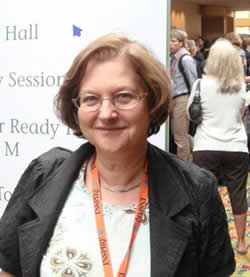
Fig 19. Tacjana Pressler
Copenhagen CF centre and 45 patients completed 1-year of treatment. The authors concluded that long-term, low-dose AZ treatment in adult CF patients with chronic P. aeruginosa infection was safe and reduced the rate of decline in lung function, increased weight, and reduced the percentage of mucoid strains of P. aeruginosa in sputum samples
This was a useful observational study from a major centre where the previous standard of treatment was known to be high – even so, there was further improvement with the addition of azithromycin to their usual treatment regimen (see also Everard et al, 1997; Jaffe et al, 1998; Equi et al, 2002; Saiman et al, 2003 – all above).
Professor Tacjana Pressler (fig.19) succeeded the late Dr Christian Koch as Medical Director of the Copenhagen CF Centre (see www.Biomedexperts.com). She one of Europe’s leading experts on cystic fibrosis and has published on a wide variety of aspects of CF. She is also on the editorial board of the Journal of Cystic Fibrosis and the Board of the European CF Society.
Christine Hansen (fig 18b) was a paediatrician in the CF unit who coordinated the study
Hoppe B, von Unruh GE, Blank G, Rietschel E, Sidhu H, Laube N, Hesse A. Absorptive hyperoxaluria leads to an increased risk for urolithiasis or nephrocalcinosis in cystic fibrosis. Am J Kidney Dis 2005; 46:440-445. [PubMed] Absorptive hyperoxaluria and hypocitraturia are the main culprits for the increased incidence of urolithiasis and nephrocalcinosis in patients with CF. The authors advocate high fluid intake, low-oxalate/high-calcium diet, and alkali citrate medication, if necessary. Additional studies are necessary to determine the influence of Oxalobacter species or other oxalate-degrading bacteria on oxalate handling in patients with CF.
de Jong PA, Nakano Y, Hop WC, Long FR, Coxson HO, Paré PD, Tiddens HA. Changes in airway dimensions on computed tomography scans of children with cystic fibrosis. Am J Respir Crit Care 2005; 172:218-224. [PubMed] To quantify airway wall thickening and lumen dilatation in children with CF over a 2-year interval. In CF, quantitative measurements of airways on CT scans show an increased ratio between airway lumen area and arterial area and progressive airway wall thickening. Scoring systems show progression of bronchiectasis but unchanged airway wall thickness and pulmonary function tests remain stable.
Hardin DS, Ferkol T, Ahn C, Dreimane D, Dyson M, Morse M, Prestidge C, Rice J, Seilheimer DK. A retrospective study of growth hormone use in adolescents with cystic fibrosis. Clin Endocrinol 2005; 62:560-566. [PubMed]

Fig 20. Dana Hardin
The results of this study suggest that growth hormone use in pubertal adolescents with CF safely improves height, body weight, bone mineralization and clinical status. Hardin and colleagues have published a number of studies on the use of growth hormone in CF.In 2012 a muticentre trial of daily growth hormone injections over a year confirmed the significant beneficial effect of the treatment (Stalvey MS et al. Pediatr Pulmonol 2012; 47:252-263. below [PubMed]).
Dr. Dana Hardin (fig.20) is a paediatrician and paediatric endocrinologist in Columbus, Ohio. Her clinical and research interests include cystic fibrosis, growth disorders, the chronically ill and diabetes. She has written extensively the use of growth hormone in children with CF. She is the Study Section Chair of the NIH, SBIR/STTR Endocrinology and Metabolism. She has been a member of both the N. American and European CF bone consensus groups.
Hartl D, Starosta V, Maier K, Beck-Speier I, Rebhan C, Becker BF, Latzin P, Fischer R, Ratjen F, Huber RM, Rietschel E, Krauss-Etschmann S, Griese M. Inhaled glutathione decreases PGE2 and increases lymphocytes in cystic fibrosis lungs. Free Radical Bio Med 2005; 39:463-472. [PubMed]
Reduced glutathione (GSH), a major antioxidant and modulator of cell proliferation, is decreased in the bronchoalveolar lavage fluid (BALF) of cystic fibrosis (CF) patients. GSH inhalation in CF patients significantly increased GSH levels in BALF and improved lung function (M. Griese et al., 2004, Am. J. Respir. Crit. Care Med.169, 822-828.[PubMed]). GSH depletion in vitro enhances susceptibility to oxidative stress, increases inflammatory cytokine release, and impairs T cell responses.
BALF from 17 CF patients (median FEV1 67% (43-105%) of predicted) was assessed before and after GSH inhalation for total protein, markers of oxidative stress (8-isoprostane, myeloperoxidase, and ascorbic and uric acid), pattern of protein oxidation, prostaglandin E2 (PGE2), and proinflammatory cytokines. BALF cells were differentiated using cytospin slides, and lymphocytes were further analyzed by flow cytometry.Inhalation of GSH decreased BALF levels of PGE2 and increased CD4+ and CD8+ lymphocytes in BALF significantly but had no effect on markers of oxidative stress. BALF lymphocytes correlated positively with lung function, whereas levels of PGE2 showed an inverse correlation.
The patients with the greatest improvement in lung function after GSH treatment also had the largest decline in PGE2 levels. So GSH inhalation in CF patients increases lymphocytes and suppresses PGE2 in the bronchoalveolar space. Thus, GSH primarily affected the pulmonary immune response rather than the oxidative status in CF patients. The authors suggested that the effect of GSH inhalation on PGE2 levels and lymphocytes in CF warrants further investigation.There is continuing interest in the role of glutathione in cystic fibrosis.
Jones AM, Dodd ME, Govan JR, Doherty CJ, Smith CM, Isalska BJ, Webb AK. Prospective surveillance for Pseudomonas aeruginosa cross-infection at a cystic fibrosis center. Am J Resp Crit Care Med 2005; 171:257-260.[PubMed]
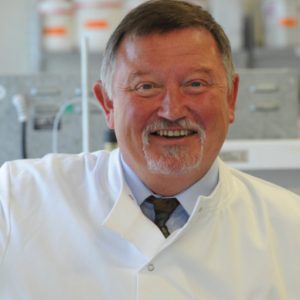
Fig 21. John Govan
ResearchGate
A 4-year prospective surveillance for Pseudomonas aeruginosa (PA) cross-infection at a large regional adult cystic fibrosis centre (Manchester, UK) showed that, despite purpose-built facilities in a new building and the practice of strict hygiene, PA cross-infection has continued. In contrast, individuals segregated from the cohort of patients with chronic PA infection but who attend the same centre have not acquired infection with transmissible PA strains. Simple infection control measures alone do not prevent the spread of some transmissible PA strains between individuals with cystic fibrosis. However, patient segregation effectively controlled spread of such strains.These were the same transmissible PA strains previously described from Manchester (Jones et al, 2001 above; Jones et al, 2002 above).So the term “highly transmissible” is very appropriate when applied to these strains of P. aeruginosa.
– Professor John Govan, (fig 21), a distinguished microbiologist from Edinburgh, was a major source of guidance for us at the CF Trust in matters regarding infection control and cross infection. Always pleasant and cheerful he was a delight to work with on our many committees and publications.
Kennedy SE, Henry RL, Rosenberg AR. Antibiotic-related renal failure and cystic fibrosis. J Paediatr Child Health 2005; 41:382-383. [PubMed]
A case of unusually severe acute tubular necrosis occurring in an adolescent with cystic fibrosis receiving i. v. gentamicin plus ceftazidime.
Yet another child with severe renal failure associated with IV gentamicin which in the UK is advised against in the UK either intravenously or by nebuliser.
Kerem E, Conway S, Elborn S, Heijerman H for the Consensus Committee. Standards of care for patients with cystic fibrosis: a European consensus. J Cystic Fibrosis 2005; 4:7-26.[PubMed]

Fig 22. Eitan Kerem
An important document developed at an ECFS Artimino conference. The document is now generally accepted throughout Europe and provides a basis for developing optimal CF care and a standard against which care in individual centres can be judged. Most European countries have accepted the standards. Full text is available on the European CF Society website (www.ecfsoc.org). There is a commentary on this report by Littlewood JM. [PubMed]
Eitan Kerem (fig. 22), is Head of the Department of Pediatrics at the Hadassah Medical Center and Professor of Pediatrics at the Hebrew University-Hadassah Medical School. His interest in CF spans all aspects.
Kerem E. Pharmacological induction of CFTR functions in patients with cystic fibrosis: mutation specific therapy. Pediatr Pulmonol 2005; 40:183-96. [PubMed]
The CF mutations can be classified according to the mechanisms by which they disrupt CFTR function. This understanding of the different molecular mechanisms of CFTR dysfunction provides the scientific basis for the development of targeted drugs for mutation-specific therapy of cystic fibrosis.Class I mutations are nonsense mutations that result in the presence of a premature stop codon that leads to the production of unstable mRNA, or the release from the ribosome of a short, truncated protein that is not functional. Aminoglycoside antibiotics can suppress premature termination codons by disrupting translational fidelity and allowing the incorporation of an amino acid, thus permitting translation to continue to the normal termination of the transcript.Class II mutations cause impairment of CFTR processing and folding in the Golgi. As a result, the mutant CFTR is retained in the endoplasmic reticulum (ER) and eventually targeted for degradation by the quality control mechanisms. Chemical and molecular chaperones such as sodium-4-phenylbutyrate can stabilize protein structure, and allow it to escape from degradation in the ER and be transported to the cell membrane.Class III mutations disrupt the function of the regulatory domain. CFTR is resistant to phosphorylation or adenosine tri-phosphate (ATP) binding. CFTR activators such as alkylxanthines (CPX) and the flavonoid genistein can overcome affected ATP binding through direct binding to a nucleotide binding fold.Class IV mutations. Phosphorylation of CFTR results in reduced chloride transport. Increases in the overall cell surface content of these mutants might overcome the relative reduction in conductance. Alternatively, restoring native chloride pore characteristics pharmacologically might be effective. Activators of CFTR at the plasma membrane may function by promoting CFTR phosphorylation, by blocking CFTR dephosphorylation, by interacting directly with CFTR, and/or by modulation of CFTR protein-protein interactions.Class V mutations affect the splicing machinery and generate both aberrantly and correctly spliced transcripts, the levels of which vary among different patients and among different organs of the same patient. Splicing factors that promote exon inclusion or factors that promote exon skipping can promote increases of correctly spliced transcripts, depending on the molecular defect. Inconsistent results were reported regarding the required level of corrected or mutated CFTR that had to be reached in order to achieve normal function
– This is a very helpful article by Eitan Kerem reviewing the various mutations and the potential means of correcting them by drug therapy at that time (in 2005). There are now (2023) specific drug treatments which will reduce or alleviate the effects of the particular mutations i.e. they are mutation specific. An examples is VX-770 (ivacaftor/Kalydeco) approved in 2012 for the treatment of people with CF carrying one or two G551D mutations; the most recent is Trikafta (tezacaftor(VX-6610) +Elexacaftor (VX-445) + Ivacaftor (VX-770)) for the 80% of the people with CF who have either one or two DF508 mutations.
Koh JL, Harrison D, Palermo TM, Turner H, McGraw T. Assessment of acute and chronic pain symptoms in children with cystic fibrosis. Pediatr Pulmonol 2005; 40:330-335. [PubMed]
The aims of this study were to: 1) assess acute and chronic pain symptoms as reported by children with CF, and 2) examine the relationship between pain symptoms and disease severity as measured by percentage of forced expired volume in 1 sec (FEV1%). Forty-six children completed a self-report questionnaire assessing characteristics of chronic disease-related pain (frequency, intensity, duration, associated emotional upset, and location of pain). Forty-six percent of the sample described pain occurring at least once per week. A small subgroup of children reported longer-lasting and moderately intense pain. Children with chest pain were found to be particularly at risk for experiencing more functional limitations and a significantly lower FEV1% compared to children without chest pain. Disease-related pain is common for children and adolescents with CF, suggesting that pain assessment should be a routine part of their clinical care.
– Pain is a common problem for people with CF and perhaps receives less attention than respiratory problems. Pain is definitely related to the disease severity. This article provides a useful up to date review of the subject which is of importance for many people with CF.
Koscik RL, Lai HJ, Laxova A, Zaremba KM, Kosorok MR, Douglas JA, Rock MJ, Splaingard ML, Farrell PM. Preventing early, prolonged vitamin E deficiency: an opportunity for better cognitive outcomes via early diagnosis through neonatal screening. J Pediatr 2005; 147:S51-6. [PubMed]

Fig 23. Rebecca Koscik
The objective of this study was to evaluate cognitive function in children with CF and the influence of both early diagnosis through neonatal screening and the potential effect of early malnutrition. Significantly lower cognitive scores correlated with indicators of malnutrition and un favourable family factors such as single parents, lower socioeconomic status, and less parental education. Results suggest that prevention of prolonged malnutrition by early diagnosis and nutritional therapy, following neonatal screening, particularly minimizing the duration of vitamin E deficiency, is associated with better cognitive functioning in children with CF.Thus important evidence that diagnosis via newborn screening may possibly benefit the cognitive development of children with CF, particularly in those prone to vitamin E deficiency during infancy, which is the majority. Another important positive in favour of newborn screening for CF from the Wisconsin study.
Dr Rebecca Langhough Koscik (fig 23) is a scientist with the Wisconsin Alzheimer’s Institute
Lin YC, Ly H, Golianu B. Acupuncture pain management for patients with cystic fibrosis: a pilot study. Am J Chin Med 2005; 33:151-156. [PubMed].
Acupuncture was found to be effective in decreasing pain complaints in patients with cystic fibrosis. No side effects or complications were reported in relation to the acupuncture treatment. Acupuncture is effective for managing symptoms and illnesses associated with cystic fibrosis. Further randomized controlled trials will be necessary to evaluate additional efficacy in pain management and the improvement of the quality of life of patients with cystic fibrosis.
– There are no further publications (to 2023) on the use of acupuncture in people with cystic fibrosis.
O’Mahony M, Skehan S, Gallagher C. Percutaneous stenting of the superior vena cava syndrome in a patient with cystic fibrosis. Irish Med J 2005; 98:85-86. pubmed.ncbi.nlm.nih.gov/15869067/

Fig 24. Charles Gallagher
svcpc.ie
Superior vena cava (SVC) obstruction commonly occurs in the setting of malignancy. Cases of benign SVC obstruction are being seen more frequently with the use of long-term central venous lines. This is the case particularly in Cystic Fibrosis (CF). The authors describe in this report the successful use of intravascular stenting to treat this distressing condition in the setting of thrombotic occlusion of the SVC in a patient with cystic fibrosis.
Professor Charles Gallagher (Fig. 24) is Professor Medicine at St Vincent’s Hospital in Dublin.
Panagea S, Winstanley C, Walshaw MJ, Ledson MJ, Hart CA. Environmental contamination with an epidemic strain of Pseudomonas aeruginosa in a Liverpool cystic fibrosis centre, and study of its survival on dry surfaces. J Hosp Infect 205; 59:102-107. [PubMed]
The authors conducted an environmental survey in the Liverpool adult cystic fibrosis (CF) centre in order to determine the extent of environmental contamination with an epidemic strain of Pseudomonas aeruginosa that colonizes most CF patients in Liverpool, and to identify possible reservoirs and routes of cross-infection. In addition, they studied the survival of this strain on dry surfaces, compared with that of other CF P. aeruginosa strains, to explore factors that might contribute to its high transmissibility.
Environmental contamination with Liverpool strain (LES) was only detected in close proximity to colonized patients (external surfaces of their respiratory equipment, and spirometry machine tubing and chair) and was short-lived. No persistent environmental reservoirs were found. LES was detected in the majority of air samples from inside patients’ rooms, the ward corridor and the outpatient clinic. Survival of LES on dry surfaces was significantly longer than that for some other strains tested, but not compared with other strains shown not to be transmissible.
It was concluded improved environmental survival on its own, therefore, cannot explain the high transmissibility of this epidemic strain. The findings suggests that airborne dissemination plays a significant role in patient-to-patient spread of LES, and confirms the need to segregate those patients colonized by epidemic P. aeruginosa strains from all other CF patients.
– A helpful study when considering the management of patients infected with highly transmissible strains of P. aeruginosa.
Malfroot A, Adam G, Ciofu O, Doring G, Knoop C, Lang AB, Van Damme P, Dab I, Bush A. European Cystic Fibrosis Society (ECFS) Vaccination Group.Immunisation in the current management of cystic fibrosis patients. J Cyst Fibros 2005; 4:77-87. [PubMed]

Fig 25. Anne Malfroot Linkedin
Although no special recommendations exist, clearly patients with cystic fibrosis (CF) can benefit from immunisation. The group reviewed the literature regarding vaccination in CF and other chronic diseases.
CF subjects should follow national immunisation programmes without delay to obtain optimal vaccination coverage. Indeed they may escape normal programmes due to frequent hospital admissions and school absenteeism and may be more at risk to get “vaccine-controlled” diseases at any age. There is no uniform European immunisation schedule for basic infant and childhood vaccines or for vaccines against hepatitis A (HAV) and B (HBV), varicella (VZ) and booster vaccinations. HAV and HBV vaccination is appropriate in CF as recommended in general for patients with chronic liver disease (CLD). Varicella (VZ) vaccination is not recommended in all European countries. There are no recent data about possible worsening of pulmonary status following VZ in CF, but it is known to cause pulmonary damage in non-CF adults and to be potentially fatal post transplantation and during steroid treatment. Therefore it is recommended at least for seronegative adolescents and transplant candidates. Influenza vaccine is recommended annually for CF patients aged > or =6 months. Pneumococcal vaccine is generally indicated for CF patients. RSV infection might play a role in the initial Pseudomonas colonization and the decline in pulmonary function. However no RSV vaccine is available at present. There are no recommendations for palivizumab in CF as an alternative but expensive prophylaxis. Anti-bacterial vaccinations protecting directly against Pseudomonas aeruginosa colonisation are promising for the future, potential candidates are currently being assessed in phase III clinical trials. More studies are needed to complete recommendations especially for CF adults and transplant candidates.
This represents the current recommendations in 2005 for the immunisation of people with CF. Not all the recommendations are supported by evidenced based studies but all by welcome common sense and experience!
Dr Anne Malfroot (fig 25) is Professor in Pediatrics at the Vrije Universiteit Brussel VUB University in Brussels.
Quittner AL, Buu A, Messer MA, Modi AC, Watrous M. Development and validation of The Cystic Fibrosis Questionnaire in the United States: a health-related quality-of-life measure for cystic fibrosis. Chest 2005; 128:2347-2354. [PubMed]

Fig 26. Alexandra Quittner
The Cystic Fibrosis Questionnaire (CFQ) is a disease-specific instrument that measures health-related quality of life (HRQOL) for adolescents and adults with cystic fibrosis (CF) > or = 14 years, consisting of 44 items on 12 generic and disease-specific scales. Versions of the CFQ are also available for children with CF and their parents. This study evaluated the psychometric properties of the CFQ in a national study at 18 CF centers in the United States. The results demonstrated that the CFQ-teen/adult is a reliable and valid measure of HRQOL for individuals with CF. It may be utilized in clinical trials to assess the effects of new therapies, to document the progression of disease, and to inform clinical practice.
Professor Alexandra Quittner (fig.26) is Professor of Psychology in the University of Miami. She has a varied research programme including several NIH and CF Foundation funded studies. CF studies relate to adherence to treatment, depression and anxiety and the links to health outcomes, and quality of life measures.
Riordan JR. Assembly of functional CFTR chloride channels. Ann Rev Physiol 2005; 67:701-718. [PubMed]

Fig 27.Jack Riordan
A review article by Jack Riordan, one of the co-discoverers of the CF gene. In summary, the assembly of the CFTR chloride channel is of interest from the broad perspective of understanding how ion channels and ABC transporters are formed as well as dealing with the mis-assembly of CFTR in cystic fibrosis. Disease-associated mutations, including the most common, DeltaF508, interfere with domain folding and association, which occur both co- and post-translationally. The biosynthetic processing of the nascent polypeptide leading to channel assembly involves transient interactions with numerous chaperones and enzymes on both sides of the endoplasmic reticulum membrane.
Robinson TE, Goris ML, Zhu HJ, Chen X, Bhise P, Sheikh F, Moss RB. Dornase alfa reduces air trapping in children with mild cystic fibrosis lung disease: a quantitative analysis. Chest 2005; 128:2327-35. [PubMed]
Twenty-five children with CF randomized to either daily rhDNase or placebo aerosol were evaluated at baseline, and at 3 months and 12 months by spirometer-triggered HRCT and spirometry. After 3 months of treatment, both groups had improvements in percentage of predicted FEV1 and FEF(25-75%), and total HRCT visual scores. In contrast, the rhDNase group had a 13% decrease in quantitative air trapping from baseline (severe air trapping [A3]), compared to an increase of 48% in the placebo group (p = 0.023). Quantitative air trapping (A3) remained improved in the rhDNase group (- 15.4%) and worsened in the placebo group (+61.3%) with nearly significant differences noted between groups (p = 0.053) after 12 months of treatment.The authors concluded that quantitative air trapping is a more consistent sensitive outcome measure than either spirometry or total HRCT scores, and can discriminate differences in treatment effects in children with minimal CF lung disease.
– One of the earliest signs of CF is air trapping and over inflation on the chest X-ray. it would be reasonable to expect this to improve with rhDNase treatment as occurred in this study. Indeed, in recent years many paediatricians are now trying young children on rhDNase as soon as they are able to inhale it.
Saiman L, Mayer-Hamblett N, Campbell P, Marshall BC. Macrolide Study Group. Heterogeneity of treatment response to azithromycin in patients with cystic fibrosis. Am J Resp Critl Care 2005; 172:1008-1012. [PubMed]
Azithromycin participants in the previous CFF azithromycin trial experienced benefits in exacerbation parameters, hospitalisations and use of additional oral antibiotics regardless of whether their FEV1 improved or not during the trial. The authors suggest that these data have implications for clinical practice and the design of clinical trials.
Sims EJ, McCormick J, Mehta G, Mehta A. Steering Committee of the UK Cystic Fibrosis Database. Neonatal screening for cystic fibrosis is beneficial even in the context of modern treatment. J Pediatr 2005; 147(3 Suppl):S42-46. [PubMed].

Fig 28. Erika Sims
To determine whether early identification of babies with cystic fibrosis (CF) improves outcome in the current environment of new improved treatments, considering the criticism that there may be only marginal benefit gained by CF newborn screening (NBS). They tested whether CF NBS in the setting of modern CF centre care still afforded benefit, using the UK CF Database (UKCFD) to compare clinical outcomes in infants who underwent NBS and control subjects who were clinically diagnosed (CD). With Mann-Whitney rank tests, 184 patients who underwent NBS aged 1 to 9 years in 2002 (excluding meconium ileus) were compared with matched patients who were CD in 3-year age groups (950 control subjects).
RESULTS: Patients as old as 6 years who underwent NBS had significantly greater median height z-scores, less severe Northern chest X-ray scores, better Shwachman-Kulczycki scores, and lower rates of chronic Pseudomonas aeruginosa infection. No difference was found for weight z-score or % predicted forced expiratory value in 1 second or forced volume capacity. Nutritional benefit was demonstrated in patients who underwent NBS and were homozygous for the DeltaF508 mutation.CONCLUSIONS: NBS segregates with better outcomes in patients as old as 6 years compared with age- and gene-matched control subjects who are CD. This cross-sectional study shows that infants who undergo screening derive nutritional benefit in improved median height and reduced morbidity.
Dr Erika Sims (fig. 28) produced an impressive number of very useful publications many based on the data in the UK CF Registry in the years when the registry was based at Dundee. Her publications have mainly concerned asthma and cystic fibrosis; in many she has combined with Jonathan McCormick and Anil Mehta. Erika is now (2023) NCTU Operations Manager, Norwich Medical School and a member of the Norwich Clinical Trials Unit.
Sims EJ, McCormick J, Mehta G, Connett G, Mehta A. UK CF Database Steering Committee. Newborn screening for cystic fibrosis is associated with reduced treatment intensity. J Pediatr 2005; 147:306-311. [PubMed]
To determine whether the improved clinical status of children with CF diagnosed after newborn screening was associated with reduced need for treatment compared with a clinical diagnosis. Those diagnosed after neonatal screening received significantly fewer and less demanding therapies. So CF populations diagnosed by newborn screening are associated with reduced treatment requirements compared with age- and genotype-matched control subjects.
This is one of a number of important papers by written by Erika Sims (fig. 28) using data from the UK CF Database. Although the condition of children diagnosed by neonatal screening was similar to those diagnosed clinically it took a great deal more expensive and time consuming treatment to keep them in good condition; this was also the experience of others caring for children with CF.
Smyth A, Tan K H-V, Hyman-Taylor P, Mulhearn M, Lewis S, Stableforth D, Knox A, for the TOPIC study group. Once versus three-time daily regimens of tobramycin treatment for pulmonary exacerbations of cystic fibrosis – the TOPIC study: a randomised controlled trial. Lancet2005; 365:573-578. [PubMed]

Fig. 29 Alan Smyth
An important trial the results of which had a definite influence on patient management. The trial was coordinated by Dr Alan Smyth of Nottingham. 219 patients (107 had once and 112 thrice daily tobramycin) and both regimens were of equal efficiency for treating pulmonary exacerbations. There was a suggestion that the once daily regimen might be less nephrotoxic in children.
The results of this trial allowed the once daily treatment to be confidently recommended by the CF Trust’s Antibiotic Group (2009) for both adults and children with CF and also resulted in a number of other publications on pharmacokinetics and lack of ototoxicity in the trial (Mulheran M et al, Antimicrob Agents Chemother 2006; 50:2293-2299. [PubMed]) and nephrotoxicity (Smyth et al. Thorax 2008; 63:532-535. [PubMed]).
Alan Smyth (fig 29) is Professor of Paediatrics in Nottingham University.
Spencer H, Rampling D, Aurora P, Bonnet D, Hart SL, Jaffé A. Transbronchial biopsies provide longitudinal evidence for epithelial chimerism in children following sex mismatched lung transplantation. Thorax 2005; 60:60-62. [PubMed]
Recent reports have shown evidence of host derived parenchymal engraftment in several human allografts including the lung, leading to speculation that stem cell therapy may be useful for lung repair in diseases such as cystic fibrosis (CF). To date, previous studies have looked at single surgical or autopsy specimens and no longitudinal studies have been reported. The aim of this study was to assess whether transbronchial biopsies could be used to study the time course of chimerism following lung transplantation. METHODS: Specimens of archived transbronchial lung biopsies from five time points taken for clinical purposes from two boys who had received a sex mismatched heart-lung transplant for end stage CF were examined. Sections were dual stained for cytokeratin (epithelium) and a mixture of leucocyte common antigen and CD68 for inflammatory cells. Co-localisation of cells containing a Y chromosome was confirmed by fluorescent in situ hybridisation.Evidence of chimerism was found in up to 6.6% of epithelial cells in bronchial (median 1.4% (range 0-6.6)) and alveolar (median 3.6% (range 2.3-5.5) tissue without apparent evidence of fusion. This engraftment was seen as early as 3 weeks and remained relatively constant up to 37 months.
This study has demonstrated proof of principle for long term chimerism in lung epithelium. The authors suggest that transbronchial biopsies may provide a new method for studying the kinetics of stem cell engraftment in the lung.
Taccetti G, Campana S, Festini F, Mascherini M, Doring G. Early eradication therapy against Pseudomonas aeruginosa in cystic fibrosis patients. Eur Respir J 2005; 26:458-461. [PubMed]
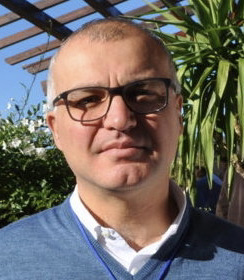
Fig 30 Giovanni Taccetti. Italian Cystic Fibrosis Research Association
Early antibiotic treatment of lung infection in people with CF has been shown to lead to eradication of Pseudomonas aeruginosa (PA). Early antibiotic therapy leads to a PA free-period of a median (range) of 18 (4-80) months. New acquisition with different PA genotypes occurs in 73% of episodes. It also delays the decline of lung function compared with chronically infected patients. The treatment substantially lowers chronic PA prevalence in CF.
– Yet more evidence that early antibiotic therapy of P. aeruginosa infection exerts beneficial effects on the patient’s clinical status and is cost-effective compared with conventional antibiotic therapy for chronically infected cystic fibrosis patients.
Giovanni Tacetti (fig. 30) is at the Cystic Fibrosis Regional Reference Centre, Department of Paediatric Medicine, Meyer Children’s Hospital, Florence, Italy.
Thornton J, Elliott RA, Tully MP, Dodd M, Webb AK. Clinical and economic choices in the treatment of respiratory infections in cystic fibrosis: comparing hospital and home care. J Cyst Fibros 2005; 4:239-247.[PubMed]
The authors state that a cost-effectiveness evaluation comparing home-based and hospital-based treatment with intravenous antibiotics for respiratory exacerbations in adults with cystic fibrosis (CF) has not been previously undertaken. The study was conducted in the Manchester adult CF centre. The primary outcome measure was percentage change in FEV(1); “effectiveness” was defined as maintenance of baseline average FEV(1) over the one-year study period.116 patients received 454 courses of intravenous antibiotics. At the end of 1 year, there had been a mean percentage decline in FEV(1) compared with baseline average for home-treated patients but an improvement for hospital-treated patients. Treatment was deemed “effective” in more hospital (58.8%) than home (42.6%) patients.Hospital treatment was more effective but more expensive than home treatment. Potential methods to improve outcome at home should be considered.
Vanthanouvong V, Kozlova I, Roomans GM. Ionic composition of rat airway surface liquid determined by X-ray microanalysis. Microsc Res Techniq 2005; 68:6-12. [PubMed]
The authors describe two techniques that have been developed and used to study airway surface liquid (ASL) composition: X-ray microanalysis of frozen hydrated rat trachea, and an ion-exchange (dextran) bead method, where dextran beads were placed on the airway epithelium to equilibrate with the ASL; the beads were then collected under silicone oil, dried and analyzed by X-ray microanalysis. X-ray microanalysis is apparently a suitable method to determine the ionic composition of airway surface liquid.
Walkowiak J, Sands D, Nowakowska A, Piotrowski R, Zybert K, Herzig KH, Milanowski A Early decline of pancreatic function in cystic fibrosis patients with class 1 or 2 CFTR mutations.J Pediatr Gastroenterol Nutr. 2005 Feb;40(2):199-201. [PubMed]

Fig 31. Jaroslaw Walkowiak
There are few data regarding the decline of exocrine pancreatic function within the first years of life in relation to CF genotype. The authors assessed the decline of pancreatic function in CF infants carrying class 1 or 2 CFTR mutations who were diagnosed in a neonatal screening program.
Twenty-eight CF patients were included in the study and 27 completed the study. In all subjects, fecal pancreatic elastase-1 concentrations and fecal fat excretion were scheduled to be determined at diagnosis, at 6 months of age and subsequently at 6-month intervals
In all CF patients, fecal pancreatic elastase-1 concentrations of the first assay after diagnosis (3 to 4 months of age) were lower than the cut-off level for normals of <200 microg/g stool. Steatorrhea was found in 81.5% of these subjects. At the age of 6 months, all screened CF subjects had fecal pancreatic elastase-1 concentrations <100 microg/g and at the age of 12 months all were pancreatic insufficient. At that time, having proved pancreatic insufficiency in all studied subjects, we stopped the scheduled further assessment.
The authors conclude that CF patients require careful monitoring of pancreatic status from diagnosis onwards. In patients carrying class 1 or 2 CFTR mutations, pancreatic insufficiency develops in the first months of life. The proper assessment of pancreatic insufficiency and intestinal malabsorption is crucial for the early introduction of pancreatic enzymes.
Professor Jaroslaw Walkowiak (fig.31) of Department of Pediatric Gastroenterology and Metabolism, Poznań University of Medical Sciences, Poznań, Poland is one of Europe’s leading paediatric gastroenterologists. He has published on many aspects of paediatric gastroenterolgy and particularly on cystic fibrosis and has been actively involved in the European CF Society’s working groups and guidelines committees.
Wang G, Bunnell BA, Painter RG, Quiniones BC, Tom S, Lanson NA Jr, Spees JL, Bertucci D, Peister A, Weiss DJ, Valentine VG, Prockop DJ, Kolls JK. Adult stem cells from bone marrow stroma differentiate into airway epithelial cells: potential therapy for cystic fibrosis. Proc Nat Acad Sci 2005; 102:186-191. [PubMed]

Fig. 32 Guoshun Wang LSU Health New Orleans
Marrow stromal stem cells (MSCs) possess the capacity of differentiating into airway epithelia. MSCs from CF patients are amenable to CFTR gene correction, and expression of CFTR does not influence the pluripotency of MSCs. Moreover, the CFTR-corrected MSCs from CF patients are able to contribute to apical Cl(-) secretion in response to cAMP agonist stimulation, suggesting the possibility of developing cell-based therapy for CF. The ex vivo coculture system established in this report offers an invaluable approach for selection of stem-cell populations that may have greater potency in lung differentiation.
So stem cells from the marrow of people with CF could be treated with gene therapy and still develop into airway epithelia and function as chloride channels when they reached the lungs. Another attractive potential method of correcting the basic defect in respiratory epithelium.
Professor Guoshun Wang (Fig. 32) is at the Departments of Medicine and Genetics, Gene Therapy Program, Louisiana State University Health Sciences Center, 533 Bolivar Street, New Orleans,
Young AL, Peters CJ, Toogood GJ, Davies MH, Millson CE, Lodge JP, Pollard SG, Prasad KR. A combined liver-pancreas en-bloc transplant in a patient with cystic fibrosis. Transplantation 2005; 80:605-607. [PubMed]

